After building a side-yard gate out of rough fencing redwood, I had a
few boards left over. Rather than purchase new, smooth-finished redwood
for the bathroom shelf, I chose to plane and sand the left-over fencing
boards and use those instead.
| Click on the thumbnails to view details |
 |
This is a close-up of the end of the board before planing. sanding,
and cutting to size.
|
 |
The redwood boards after planing, sanding, and cutting.
|
 |
A different view of the same boards (and my rather saw-dusty work
bench!)
|
 |
After cutting the contours in the side panels, and before routing
the edges (those bench clamps are wonderful!)
|

|
Sanded, routed, and assembled: No nails; just tongue-and-groove
and mortise-and-tenon joints, glued and clamped.
The machine in the background is my Dad's 1963-vintage 240-volt
Dewalt 10-inch radial arm saw: An absolutely indespensible and versatile
tool.
|
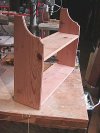 |
A close-up shot of the edge routing, also showing the redwood grain.Next
step: Stencil in the grape leaf designs on the side panels, and
start carving!
|
 |
Applying the first part of the stencil.
|
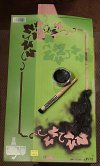 |
...and the second part
|
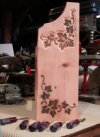 |
Carving out the design, 1/4 of the way done (got the other side
to do!)
|
 |
Of course, my craftmanship has to pass inspection by Simba...
|
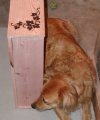 |
I think I passed 8*)
|
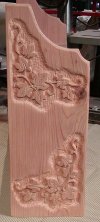 |
Carving completed... next step; using leather-stains to color in
the leaves and stems.
Yes, fellow wood-workers; that knot was very hard to work! Talk
about having to resharpen tools... (Oy!)
|
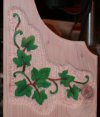 |
One beautiful aspect of leather-stain colors is that they are transparent,
and thus do not hide the wood grain.S
|
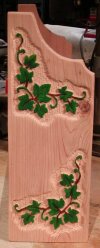 |
Stain application completed; next step - apply Teak Oil finish.
|
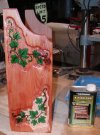 |
Teak oil brngs out the color of redwood! Look at contrast between
the treated and untreated sections!
|
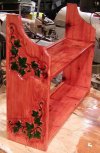 |
... Teak oil finish, completed.
|
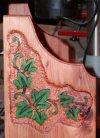 |
Close-up of one of the carvings after the teak oil application...
|
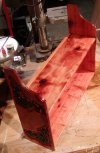 |
A different view that shows the redwood grain very well.
|
 |
Last, but not least: a close-up of part of the redwood grain; a
knot next to ripple-grain
|


















